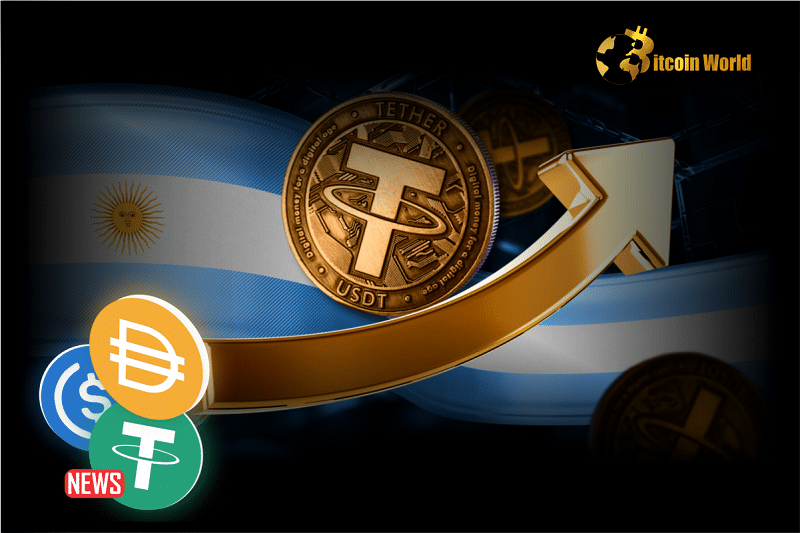Argentina, a nation synonymous with economic volatility, has taken an interesting turn in the crypto world. Plagued by a severe economic crisis and a peso that seems to be perpetually on a downward spiral, Argentina has surprisingly emerged as the undisputed leader in Latin America when it comes to stablecoin purchases and holdings. This intriguing trend, highlighted in a recent report by crypto exchange Bitso, paints a fascinating picture of how people are adapting to financial instability in the digital age.
Bitso’s comprehensive report, ‘Crypto Landscape in Latin America: Report 2H 2023’, dives deep into the crypto adoption trends across Latin America, focusing on countries with significant crypto activity like Colombia, Argentina, Brazil, and Mexico. Let’s unpack why Argentina is standing out from the crowd, particularly in its preference for stablecoins.
Why Are Argentinians Choosing Digital Dollars Over Bitcoin?
Across Latin America, cryptocurrencies have seen a significant surge in popularity throughout late 2022 and 2023. This growing acceptance reflects a population seeking alternative financial avenues amidst market fluctuations and local economic hardships. However, Argentina’s crypto behavior is unique. It’s the only country in the region where the demand for ‘digital dollars’ – stablecoins – dwarfs the demand for other cryptocurrencies by a staggering five times!
The Bitso report reveals some eye-opening statistics. In Argentina, a whopping 60% of crypto purchases on the platform were for dollar-pegged stablecoins like USDT and USDC. Bitcoin, often hailed as ‘digital gold,’ only accounted for a mere 13% of purchases. This is a stark contrast to Colombia, Brazil, and Mexico, where stablecoin acquisitions made up between 31% and 40% of total crypto buys. Interestingly, stablecoins have become some of the fastest-growing cryptocurrencies in the Latin American region, showcasing their increasing importance.
See Also: Argentina Locals Buy ‘Stablecoins’ Secretly To Escape Inflation And Strict Currency Controls
Digging deeper, Bitso’s analysis indicates that stablecoins constitute about 26% of the average Argentine user’s crypto portfolio. This substantial holding is primarily driven by the country’s turbulent economic environment. Bitso directly attributes this high demand to Argentina’s ongoing political and economic woes, where citizens are desperately seeking refuge from relentless inflation and the devaluation of their national currency.
Argentina, the second most populous nation in Latin America and the third-largest economy, has been battling economic headwinds for years. In 2023 alone, the country faced an alarming annual inflation rate of 211.4%, intensifying concerns about financial stability. This economic instability creates a powerful push for Argentinians to find more stable stores of value to protect their savings from losing purchasing power.
In essence, Argentinians are rapidly converting their pesos into digital dollars as a direct response to the continuous erosion of their currency’s value. Despite these economic challenges, Argentina has shown a remarkable openness to crypto, ranking second in Latin America and 15th globally for crypto adoption in 2023, according to a Chainalysis report.
Bitcoin Still Reigns in Latin America, But Stablecoins are Catching Up
Argentina’s political scene recently saw a dramatic shift with the election of Javier Milei, a self-proclaimed “anarcho-capitalist,” as president. Milei’s views on Bitcoin are noteworthy. While not a full-fledged Bitcoin maximalist, he has expressed positive opinions about the cryptocurrency, calling it “the return of money to its original creator, the private sector.” He has also been a vocal critic of central banking, labeling it a “scam.”
Despite Milei’s crypto-friendly stance and Argentina’s stablecoin surge, Bitcoin remains the dominant cryptocurrency in Latin America overall. The Bitso report highlights that Bitcoin accounts for 53% of Latin American users’ crypto portfolios, slightly exceeding the global average of 50.4%. Stablecoins come in second in terms of preference, with significant growth particularly in Colombia and Argentina.
Interestingly, Mexico and Brazil show a lower stablecoin presence compared to Argentina and Colombia. Brazil, in particular, stands out for its diverse crypto market portfolio, encompassing not just Bitcoin and stablecoins, but also altcoins and even memecoins. This suggests a potentially more mature or risk-tolerant crypto market in Brazil compared to Argentina’s flight to safety with stablecoins.
Furthermore, among the countries analyzed, Colombia witnessed the most impressive year-on-year growth in registered users on crypto exchanges, boasting a remarkable 60% increase. Brazil followed with a 31% growth rate, while Mexico and Argentina experienced more moderate increases of 18% and 16%, respectively.
Bitso, serving over 8 million users across Latin America, plays a crucial role in facilitating crypto trading and reflects the escalating interest and adoption of cryptocurrencies in the region. This trend is especially pronounced as a response to economic uncertainties and currency devaluation, as seen so vividly in Argentina.
To reiterate, while Bitcoin still leads in overall holdings, stablecoins are rapidly gaining ground, particularly in countries facing economic turmoil. Bitcoin constituted 38% of the total crypto acquired in the second half of 2023 in Latin America, while stablecoins represented a significant 30%.
Disclaimer: The information provided is not trading nor financial advice. Bitcoinworld.co.in holds no liability for any trading or investments made based on the information provided on this page. We strongly recommend independent research and/or consultation with a qualified professional before making any trading or investment decisions.
#Binance #WRITE2EARN
Disclaimer: The information provided is not trading advice, Bitcoinworld.co.in holds no liability for any investments made based on the information provided on this page. We strongly recommend independent research and/or consultation with a qualified professional before making any investment decisions.


